Ellen and Jim Have a Blog, Too
We are two part-time academics. Ellen teaches in the English department and Jim in the IT program at George Mason University.


Lady Laura Kennedy: Raven's Pallisers 6:11 compared to Trollope's _Phineas Finn_ and _Redux_ · 18 May 08
Dear Readers,
In the blogs I write about 6:11 and 6:12, the final episodes of Phineas’s story, Part 1 (aka Phineas Finn) in the Pallisers (these begin 3:6), I’m going to change my technique a little. I’ve already written about how 6:11 also functions as a transition to the matter of Lizzie Eustace (played by Sarah Badel) and Lord Fawn (Derek Jacobi): 5:10 gives us a brief staging of Lord Fawn and in 6:11, we meet him paired with Lizzie Eustace. This time I want to compare how Raven and Trollope treat incidents by summarizing the episodes before offering a a summary and then an account again of the genre these films belong to.
It’s been self-evident the Pallisers films are not conceived as the type of adaptation known as faithful or apparently faithful, in Wagner’s terminology the transposition. Raven’s Pallisers represent an intermediary type of faithfulness where the film-makers keep much of the original story, characters, crucial & remembered scenes of the original story but depart radically too—to comment, to alter (often in the direction of modernizing), to emphasize and correct what the film-makers feel needs correction (often again modernizing), to adhere to modern aesthetics. In Wagner’s terminology this kind of intermediary faithful adaptation is a commentary. What I’m noticing now is happening to the material in the series is a stronger departure occurs in 6:11 through 7:14. Raven is turning Trollope’s satiric but also realistic novel, Eustace Diamonds into sheer satire, eliminating the one of the book’s major characters (a poor vulnerable governess, Lucy Morris), burlesquing one of the heroes, Fawn, diminishing the role of Trollope’s misogynistic take on a femme fatale heroine, Lizzie, and marginalizing the book’s hero, Frank Greystock (played in the series by Martin Jarvis), whose ambivalent courtship of Lucy Morris provides a counterpoint and context for Trollope’s portrait of Lizzie as a hollow liar.
So first I’ll compare Trollope’s novelistic storytelling of how Lady Laura (played in the series by Anna Massey) leaves Kennedy (Derek Godfrey) with Raven’s filmic storytelling. Then present a brief thematic summing up, together with a recounting of the episodes of 6:11, accompanied by a transcript of a key scene, & then look at the generic changes we find in the filmic Eustace Diamonds. The way Lady Laura is presented leaving Kennedy in the book versus the film can serve as a revealing instance of how we think we remember the book, and that the event happened in the way it does in the movie, but in fact somehow the vivid presentation of the events (with characters, costumes, the whole breathing apparatus of life) blots from our minds the first presentation in the book. The scenes in the book are intertwined or juxtaposed with Phineas’s other love relationships (and shed light on these); the scenes in the film show changes in personel (I’ll put it) that are taken in order to fulfill other themes and the plot-design Raven invented for the whole of the Palliser series.
To summarize the actions in the the films: in Pallisers 6:11, Kennedy is angry that Laura has invited Chiltern to Loughlinter to woo Violet and does not want to provide a fire, brandy (or cigars); he later attempts to prevent Lady Laura from writing to Phineas that Violet is now to marry Chiltern (Episode 11, Scenes 1 & 3, Loughlinter, just after & a few days after Christmas). Lady Laura decides it’s all over for her when she cannot by pleading or opening up to Kennedy get him to be generous in spirit and warm and tell her right out she can go to London because she wants to (Episode 12, Scene 5, the Chinese checkers scene]).
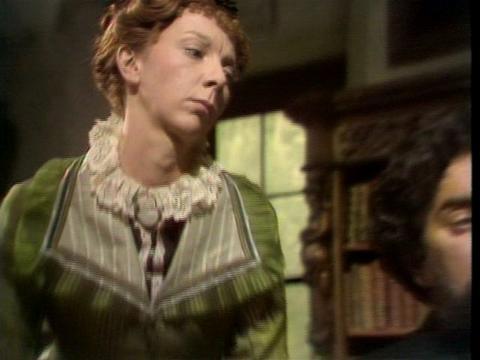
A moment of decision: Laura (Anna Massey) gets up from the floor, having tried to plead with Kennedy (Derek Godfrey) to soften and to flex, but he will not
In the film the next meeting is between Lady Laura and Phineas in Phineas’s office when she tells Phineas not to come to the flat in London, but to be ready to aid and abet her when she needs him (Episode 13, Scene 9).
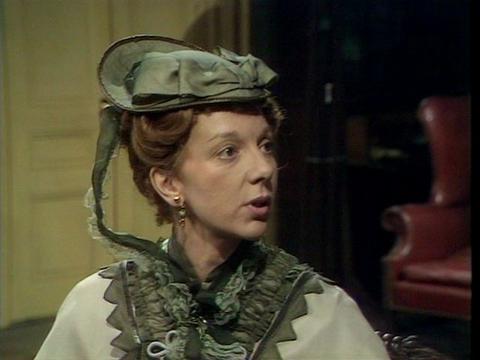
Laura serious, anxious, in need of help to escape a violent man
Kennedy does visit Finn in his office, but not to enlist his aid in getting his wife to come back (she has not yet left him); rather to forbid Phineas from seeing her (Episode 14, Scene 11, Phineas’ office).
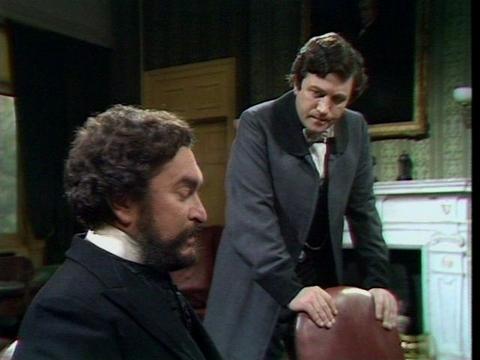
Kennedy’s closed face says he wants no interference
Then Episode 15, Scene 19 and 21. First she appears veiled and silent, with Kennedy, the second couple greeted by Lady Glencora and the Duke. The dialogue feels sinister. Lady Laura says nothing when Lady Glen says “This is the first time we’ve seen you this summer”; it is Kennedy who replies with a lie: “Yes, my wife has been unwell and unable to get about. But she insisted on coming today.”
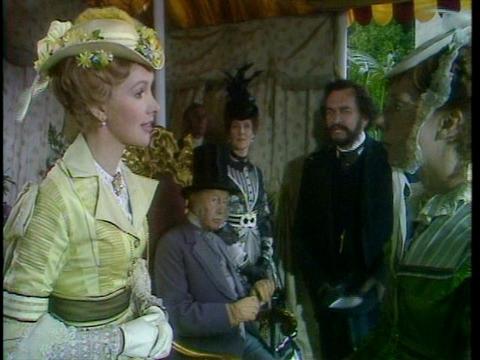
Lady Glen’s open easy face and the hidden hell of the private life Lady Laura knows are captured in the dark veil and silent face
As the party progresses, Laura seeks the aid of, and flees Kennedy with Phineas’s help in the final moments of 6:11 from the Duke of Omnium’s garden party at Gatherum:
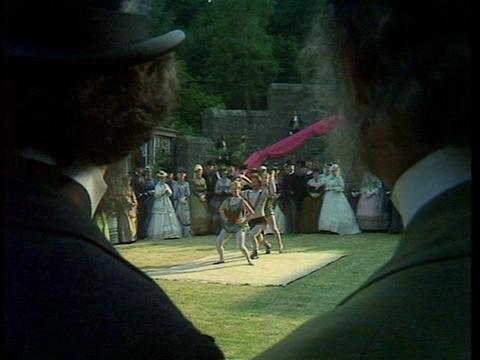
We are looking through the shoulders of Dolly Longestaffe (Donald Pickering) and Barrington Erle (Moray Watson) and the eyes of Kennedy (Derek Godfrey) catch Laura’s figure
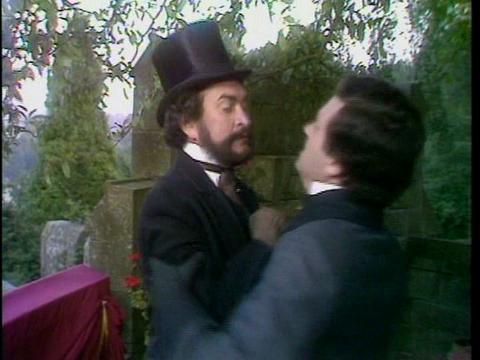
Kennedy runs up the stairs to find Phineas Finn (Donal McCann) blocking the way
Kennedy casts Phineas aside, but he does not reach his wife in time, for (after intervening quick scenes of the acrobats, showing the Duke’s collapse, and Madame Max seeking help from the Pallisers for the Duke), we next see Lady Laura climb into her father’s carriage, and drive off with him.
That’s what we have in the film.
The scenes in the film where Kennedy stops Laura from writing her letter and where she goes to Phineas are both taken from Trollope’s Phineas Finn where Laura shows Phineas a letter which explains her motives for leaving Kennedy; here she describes his jealousy and takes the stance we find in Trollope’s Emily Trevelyan in He Knew He Was Right (Phineas Finn, Ch 64, pp. 611-12, set in the scene at Horns, pp. 608-614): it is such an insult to her to be suspected of having an affair that she is above answering such a question and finds in it grounds for leaving her husband.
In the book Laura’s explanatory dialogue with Finn is preceded by his dialogue with Madame Max where he tells her Violet has rejected him and Madame Max replies that she admires him for earning his place and eventual rank, and that she too wants to be of use. To him is what she means but he does not pick up the hint. Part of Phineas’ conversation at Horns with Madame Max, Raven placed in the last episode of Volume 5 Part 10, Episode 10, “Marie’s offer,” Scene 21: the scene between Madame Max and Phineas on the sofa at Matching where she praises him and then offers him money sheerly. Part of the conversation is also placed in Volume 6 part 11, Episode 13, “The Duke’s Request,” Scene 6: Madame Max’s apartment where she consoles him for Violet’s rejection of him; and Episode 15, “The Escape,” Scene 19, the Duke and Lady Glen’s garden party where Madame Max offers Phineas the money together with herself. In the book Laura’s conversation with Phineas is followed by Violet’s conversation with Phineas (Ch 64, p. 615); Violet also says no woman could stay with such a vile accusation. In the book it is then Laura who urges Phineas to marry Madame Max although she has found marrying for money ruined her life, which irony Phineas points out to her (Phineas Finn, Ch 69, pp. 654-59); the narrator urges us to see that she is asking him to violate his innermost feelings as she did hers.
In the films in 5:10, Episode 10, “Marie’s Offer,” Scene 19, this role of “temptress” (as Trollope calls Lady Laura) is given to Lady Glen to make visible how desperate Lady Glen is to keep the Duke from marrying Madame Max because Lady Glen (back in 1:1 and 1:2 and again 2:4 & 3:5) has after all given up the dearest wishes of her heart when young, to marry a man she loved and who, after she deserted him himself self-destructed. One of the prizes held out to Lady Glen was she would be a duchess, and although in the film (and in the book), Lady Glen denies personal ambition, her desire to shine and to be a Top Girl (to echo Caryl Churchill) is obvious in her success as a hostess and aggression to be part of her husband’s career when prime minister later on. She also does want to see her son who we have evidence of her intense love for duke.
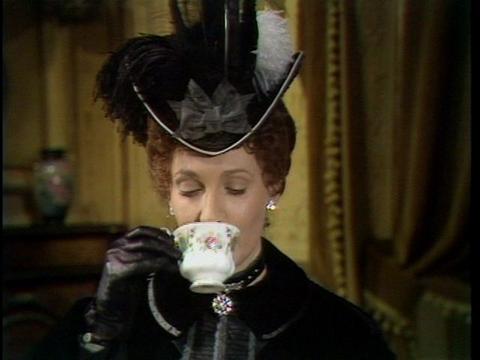
Madame Max (Barbara Murray) has come to tell Lady Glencora she has said no to the Duke; she prefers Lady Glencora’s friendship and drinking tea with her to the Duke
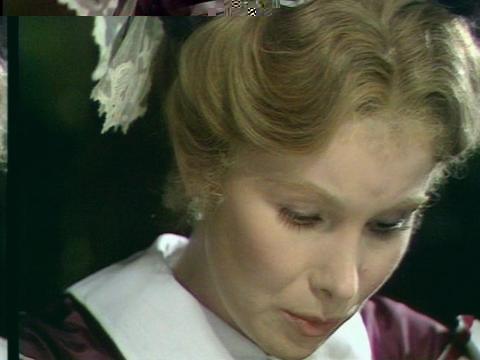
On her side, Lady Glencora (Susan Hampshire) confides in Marie (now Madame Max has become Marie) her abandoned love for Burgo Fitzgerald, what she has given up to get her present position and hopes for her and her son’s futures
Raven’s central interest across the whole series of the Pallisers is in how Lady Glen has been inexorably taken, used and can’t turn back; Trollope’s interest is more varied, in politics, and very much in the specific sets of character that dominate the different books beyond the Pallisers; Trollope is also interested in the ironical contradictions within these characters’ psychologies. Raven keeps the Palliser material the central stuff of the series; Trollope marginalizes them in the 2nd, 3rd, and 4th book of the series. In Trollope’s Autobiography he suggested Lady Laura was the greatest character in both Phineas novels.
As to aesthetics, in Trollope’s Phineas Finn, there are far more scenes than those in the Palliser films, but none of them is built up in the climactic melodramatic visual way of the films. Trollope’s scenes are longer; they are mixed with other dialogues, and narrator’s and characters’ meditations, & much, much is told in letters.
To mention just the central bits of scenes in the novels which correspond to those in the films, in the last 5th of Phineas Finn, first just before Phineas goes to Ireland, Lady Laura confides in him she must and will leave Kennedy (Ch 64, pp. 609-11); then Kennedy comes to Phineas when Phineas returns to London to ask Phineas to intercede to bring his wife back to him (Ch 68, p 643). Then later when at Lord Brentford’s Phineas meets Laura, she is staying with her father and considering not going back to live with Kennedy; and it’s here she urges Phineas to marry for money too (a real irony which Phineas is alive to, Ch 69, p 653); finally at Horns, the party in the novel it’s not the case that Lady Laura flees Kennedy to escape the marriage, but that she has already left him and shows herself there to be socially engaged; she flees only when she becomes aware he might act to seize her again. Lady Laura then vanishes for a whole novel (Eustace Diamonds), and it’s only in Phineas Redux, Chapter 2, that we are told the full details of how Laura made up her mind to leave Kennedy, and how she went abroad to flee his persecution of her.
Ellen
See various links and a concise summary of 1:1-3:6, 4:7, 4:8, 5:9, and 5:10.
--
Posted by: Ellen
* * *
Comment
commenting closed for this article
